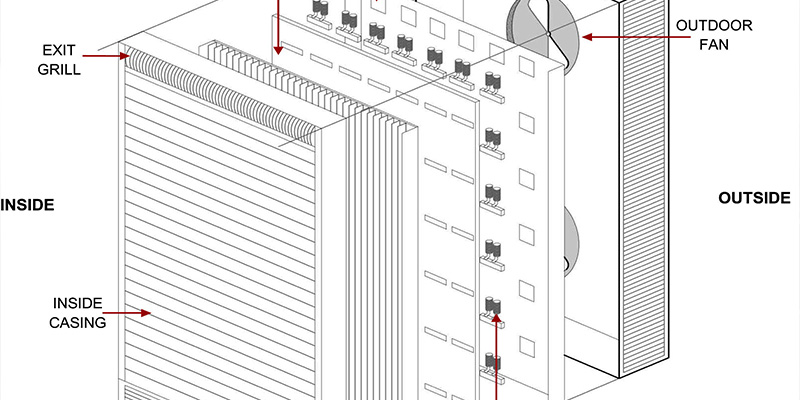Downloads
DOI:
https://doi.org/10.7480/jfde.2015.1.915Keywords:
Ventilated opaque facade, energy efficiency, Peltier, prototype, adaptive facadeAbstract
In order to fulfil the current challenges for the European building sector, building design has diverged into two alternative directions: active technologies and passive design strategies. In the last few years, advanced and responsive building envelope components have represented a promising answer to these challenges. This paper presents the design and construction process of a project that aims to design, build and control the energy performance of an industrial-scale modular active ventilated facade prototype with a new Themoelectric Peltier System (TPS). The TPS is a thermoelectric HVAC heat pump system designed to be located in the building envelope and providing a high comfort level. Trying to optimize the energy performance of the traditional ventilated opaque facade, and make more efficient the energy performance of the TPS, the concept of adaptability has been applied to ventilated opaque facades. The essential research theme is to control the natural phenomena that take place inside the ventilated air cavity of the facade: taking advantage when heat dissipation is needed, and avoiding it when heat losses are not welcome. In order to quantify the previous statements, some facade prototypes are being built in Pamplona (Spain) and their energy performance is going to be analyzed during a year.
How to Cite
Published
Issue
Section
License
Copyright (c) 2015 Marıa Ibanez-Puy, Jose Antonio Fernandez Sacristan, Cesar Martın-Gomez, Marina Vidaurre-Arbizu

This work is licensed under a Creative Commons Attribution 4.0 International License.
Authors or their institutions retain copyright to their publications without restrictions.
References
Arenas Alonso, A., Pagola de las Heras, F. L., Palacios Hielscher, R., Rodríguez Pecharromán, R., & Vázquez Arias, J. (2007). Paramento transparente activo (PTA) en aplicaciones de climatización. RE. Revista de Edificación, 101–109.
Cheng, T.-C., Cheng, C.-H., Huang, Z.-Z., & Liao, G.-C. (2011). Development of an energy-saving module via combination of solar cells and thermoelectric coolers for green building applications. Energy, 36(1), 133–140. doi:10.1016/j.energy.2010.10.061
Chwieduk, D. (2003). Towards sustainable-energy buildings. Applied Energy, 76(1-3), 211–217. doi:10.1016/S0306-2619(03)00059-X
Fabrizio, E., Corrado, V., & Filippi, M. (2010). A model to design and optimize multi-energy systems in buildings at the design concept stage. Renewable Energy, 35(3), 644–655. doi:10.1016/j.renene.2009.08.012
Favoino, F., Goia, F., Perino, M., & Serra, V. (2014). Experimental assessment of the energy performance of an advanced responsive multifunctional façade module. Energy and Buildings, 68, 647–659. doi:10.1016/j.enbuild.2013.08.066
Giancola, E., Sanjuan, C., Blanco, E., & Heras, M. R. (2012). Experimental assessment and modelling of the performance of an open joint ventilated façade during actual operating conditions in Mediterranean climate. Energy and Buildings, 54, 363–375. doi:10.1016/j.enbuild.2012.07.035
He, W., Zhou, J., Hou, J., Chen, C., & Ji, J. (2013). Theoretical and experimental investigation on a thermoelectric cooling and heating system driven by solar. Applied Energy, 107, 89–97. doi:10.1016/j.apenergy.2013.01.055
Hindrichs, D. U., & Behaling, S. (2008). Schüco E2 façade. Profile, 5, 18–37.
Loonen, R. C. G. M., Trčka, M., Cóstola, D., & Hensen, J. L. M. (2013). Climate adaptive building shells: State-of-the-art and future challenges. Renewable and Sustainable Energy Reviews, 25, 483–493. doi:10.1016/j.rser.2013.04.016
López, F. P., Jensen, R. L., Heiselberg, P., & Ruiz de Adana Santiago, M. (2012). Experimental analysis and model validation of an opaque ventilated facade. Building and Environment, 56, 265–275. doi:10.1016/j.buildenv.2012.03.017
Manioğlu, G., & Yılmaz, Z. (2006). Economic evaluation of the building envelope and operation period of heating system in terms of thermal comfort. Energy and Buildings, 38(3), 266–272. doi:10.1016/j.enbuild.2005.06.009
Marinosci, C., Strachan, P. A., Semprini, G., & Morini, G. L. (2011). Empirical validation and modelling of a naturally ventilated rainscreen façade building. Energy and Buildings, 43(4), 853–863. doi:10.1016/j.enbuild.2010.12.005
Martín-Gómez, C., Eguaras-Martínez, M., Mambrilla-Herrero, N., Torres, J., Ramos, J. C., & Rivas, A. (2010). Prototype Thermoelectric Climate System for its Use in Residential Building. In XXXVII IAHS World Congress on Housing. Santander. Retrieved from http://ezproxy.si.unav.es:2070/eds/detail?vid=3&sid=35a3f41a-3d44-4854-ba7b-c52f39deed40%40sessionmgr110&hid=102&bdata=JkF1dGhUeXBlPWlwLHVybCZsYW5nPWVzJnNpdGU9ZWRzLWxpdmU%3d#db=ir00048a&AN=dadun.10171.13927
Mesado, C., Chiva, S., Juliá, E., & Hernández, L. (2010). Two dimesnional modelling with CFD of the behavior of a ventilated ceramic façade. In J. C. F. Pereira & A. Sequeira (Eds.), V European Conference on Computational Fluid Dynamics, ECCOMAS CFD 2010. Lisbon, Portugal.
Oesterle, E., & Lieb, R.-D. (2001). Double-Skin Facades: Integrated Planning: Building Physics, Construction, Aerophysics, Air-Conditioning, Economic Viability. Munich: London: New York.
Rodriguez, A., Vián, J. G., & Astrain, D. (2008). Design and Thermal Analysis of the Components in a Thermoelectric Finger Ice-Maker Incorporated in a Domestic Refrigerator. In 6th European Conference on Thermoelectrics. París, Francia. Retrieved from http://ect2008.icmpe.cnrs.fr/Contributions/P1-21-Rodriguez.pdf
Sadineni, S. B., Madala, S., & Boehm, R. F. (2011). Passive building energy savings: A review of building envelope components. Renewable and Sustainable Energy Reviews, 15(8), 3617–3631. doi:10.1016/j.rser.2011.07.014
Schuster, H. G., & Mueller, H. F. O. (2007). Interdisciplinary Development of a Modular Façade System with Decentralised Building Services. In 2nd PALENC Conference and 28th AIVC Conference on Building Low Energy Cooling and Advanced Ventilation Technologies in the 21st Century (pp. 908–912). Crete Island, Greece. Retrieved from http://www.inive.org/members_area/medias/pdf/Inive/PalencAIVC2007/Volume2/PalencAIVC2007_V2_063.pdf
Suárez, M. J., Sanjuan, C., Gutiérrez, A. J., Pistono, J., & Blanco, E. (2012). Energy evaluation of an horizontal open joint ventilated façade. Applied Thermal Engineering, 37, 302–313. doi:10.1016/j.applthermaleng.2011.11.034
Van Dessel, S., & Foubert, B. (2010). Active thermal insulators: Finite elements modeling and parametric study of thermoelectric modules integrated into a double pane glazing system. Energy and Buildings, 42(7), 1156–1164. doi:10.1016/j.enbuild.2010.02.007
Xu, X., Dessel, S. Van, & Messac, A. (2007). Study of the performance of thermoelectric modules for use in active building envelopes. Building and Environment, 42(3), 1489–1502. doi:10.1016/j.buildenv.2005.12.021
Yamashita, O. (2008). Effect of temperature dependence of electrical resistivity on the cooling performance of a single thermoelectric element. Applied Energy, 85(10), 1002–1014. doi:10.1016/j.apenergy.2008.02.011
Yamashita, O. (2011). Effect of interface layer on the cooling performance of a single thermoelement. Applied Energy, 88(9), 3022–3029. doi:10.1016/j.apenergy.2011.03.017
